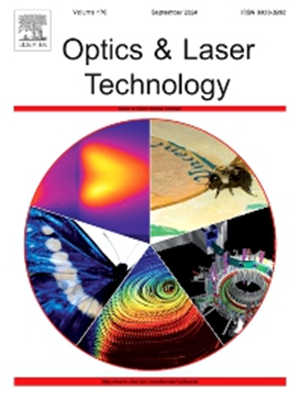Femtosecond laser-induced hierarchical micro/nanostructures of stainless-steel mesh for oil–water separation and detection of high concentration hydrogen
IF 4.6
2区 物理与天体物理
Q1 OPTICS
引用次数: 0
Abstract
A common method to control the surface wettability of materials is to construct various hierarchical micro/nanostructures followed by surface modification. The femtosecond (fs) laser-induced nanostructures with different morphologies combined with surface modification techniques can be used to adjust the wettability of stainless-steel mesh (SSM). Different micro/nanostructures can be induced by adjusting the fs laser processing parameters, such as laser energy density and scanning interval, transforming the intrinsic slightly hydrophobicity of SSM to hydrophilicity. The hydrophilic surface of fs laser treated-SSM (Fs-SSM) can be used for light oil–water separation with a separation rate of up to 99.64%. Without complex processes and toxic modifiers, the combination of polydimethylsiloxane (PDMS) vapor deposition technology can transform the hydrophilic surface into a hydrophobic surface, achieving the heavy oil–water separation with an average separation efficiency of 99.82%. Moreover, the surface of Fs-SSM coated with palladium (Pd) nanoparticles can be converted from hydrophobic to hydrophilic in hydrogen environment using Pd thermal evaporation coating technology. Upon re-exposure to air, the hydrophobicity of the surface can be restored. This work introduces inventive method to fabricate low-cost, energy-efficient and eco-friendly oil–water separation mesh, while also providing a visual means of detecting higher concentrations of hydrogen.
用于油水分离和高浓度氢检测的飞秒激光诱导不锈钢网分层微/纳米结构
控制材料表面润湿性的常用方法是构建各种分层微/纳米结构,然后进行表面改性。飞秒(fs)激光诱导的不同形态的纳米结构与表面改性技术相结合,可用于调节不锈钢网(SSM)的润湿性。通过调整 fs 激光加工参数(如激光能量密度和扫描间隔),可以诱导出不同的微/纳米结构,从而将不锈钢网的固有疏水性转化为亲水性。经过fs激光处理的SSM(Fs-SSM)亲水表面可用于轻质油水分离,分离率高达99.64%。无需复杂工艺和有毒改性剂,结合聚二甲基硅氧烷(PDMS)气相沉积技术,可将亲水表面转化为疏水表面,实现重油水分离,平均分离效率达 99.82%。此外,利用钯(Pd)热蒸发涂层技术,Fs-SSM 涂层纳米钯(Pd)表面可在氢环境中从疏水转变为亲水。当再次暴露于空气中时,表面的疏水性即可恢复。这项研究创造性地提出了一种制造低成本、高能效和环保型油水分离网的方法,同时还提供了一种检测高浓度氢气的可视化手段。
本文章由计算机程序翻译,如有差异,请以英文原文为准。
求助全文
约1分钟内获得全文
求助全文
来源期刊
CiteScore
8.50
自引率
10.00%
发文量
1060
审稿时长
3.4 months
期刊介绍:
Optics & Laser Technology aims to provide a vehicle for the publication of a broad range of high quality research and review papers in those fields of scientific and engineering research appertaining to the development and application of the technology of optics and lasers. Papers describing original work in these areas are submitted to rigorous refereeing prior to acceptance for publication.
The scope of Optics & Laser Technology encompasses, but is not restricted to, the following areas:
•development in all types of lasers
•developments in optoelectronic devices and photonics
•developments in new photonics and optical concepts
•developments in conventional optics, optical instruments and components
•techniques of optical metrology, including interferometry and optical fibre sensors
•LIDAR and other non-contact optical measurement techniques, including optical methods in heat and fluid flow
•applications of lasers to materials processing, optical NDT display (including holography) and optical communication
•research and development in the field of laser safety including studies of hazards resulting from the applications of lasers (laser safety, hazards of laser fume)
•developments in optical computing and optical information processing
•developments in new optical materials
•developments in new optical characterization methods and techniques
•developments in quantum optics
•developments in light assisted micro and nanofabrication methods and techniques
•developments in nanophotonics and biophotonics
•developments in imaging processing and systems

 求助内容:
求助内容: 应助结果提醒方式:
应助结果提醒方式:


